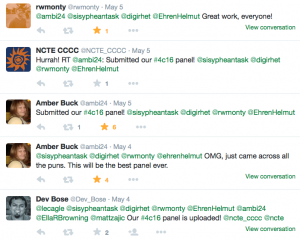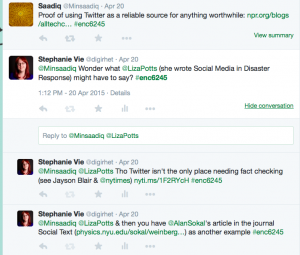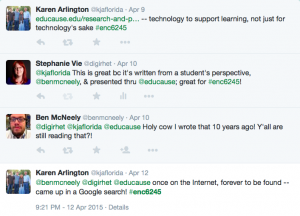Tags: Communication, Interaction, Social Media, Twitter
Description
Twitter is a social network that allows individuals to follow other users, post their own tweets, and create a network within which they can communicate. Participants on Twitter receive a Twitter “handle” or username, which is preceded by an “at” symbol: @. For example, this author’s Twitter username is @digirhet. Discussions and conversations among users are publicly visible (unless a user’s privacy settings are set for protected tweets, which are only visible to the user’s followers). One way to engage others in a conversation directed to a particular user is to use what are called Twitter “at replies,” or @replies. These may also be called “Twitter mentions.” No matter the terminology, using the @ symbol followed directly by a Twitter user’s username will make sure that the individual will be pulled into the conversation. Using an @reply will ensure that a tweet will be publicly visible on someone’s Twitter feed, and it will additionally be sent to their notifications tab in the Twitter interface. Because one of the benefits of Twitter is the ability to move the classroom beyond the walled garden of the online learning management system and into larger professional networks, instructors can use @replies in Twitter to link students’ classroom conversations to members of those professional networks. Because @replies or mentions are frequently more personal messages, they tend to concentrate inside professional groups and show links that connect groups closely (Grabowicz, Ramasco, Moro, Pujol, & Eguiluz, 2012).
Link to example artifact(s)
Instructor: Dr. Stephanie Vie, Associate Professor, Writing & Rhetoric, College of Arts & Humanities
UCF Course Title: ENC 6245: Teaching Professional Writing
In this graduate-level course, students learned about pedagogical strategies for teaching professional writing at the undergraduate level—including the use of Twitter as a professional writing and networking tool. Throughout the semester, students were asked to use Twitter regularly and to begin following different Twitter users that were active in the professional writing community. The instructor required students to follow some of the authors of the required reading for this class (including articles and books) as well as some professional organizations related to professional writing, such as the Society for Technical Communication (@stc_org), the local Orlando chapter of the STC (@STCOrlando), and SIGDOC, the Association for Computing Machinery’s Special Interest Group on the Design of Communication (@SIGDOC). Students were also required to use the class hashtag (#enc6245) and begin linking to other groups relevant to professional writing with their hashtags, such as the Women in Technical Communication group, #womeninTC. Students posed questions to these groups and authors and were prompted in various discussion boards to “remember to tweet this week using the class hashtag, #enc6245”). The results were that students were introduced to various organizations necessary to practicing professional writers; they began receiving feedback and information from scholars outside of our classroom, and they began envisioning their audience as more than just the instructor but instead a wider scholarly professional network that included scholars and practitioners in the field.
Link to scholarly reference(s)
Grabowicz, P. A., Ramasco, J. J., Moro, E., Pujol, J. M., & Eguiluz, V. M. (2012). Social features of online networks: The strength of intermediary ties in online social media. PLoS ONE, 7(1). https://doi.org/10.1371/journal.pone.0029358
Citation
Vie, S. (2016). Use twitter @replies/mentions to reach out to professional networks beyond the class. In B. Chen & K. Thompson (Eds.), Teaching Online Pedagogical Repository. Orlando, FL: University of Central Florida Center for Distributed Learning. https://topr.online.ucf.edu/use-twitter-repliesmentions-to-reach-out-to-professional-networks-beyond-the-class/.Post Revisions:
- August 10, 2020 @ 19:26:53 [Current Revision]
- August 10, 2020 @ 19:26:53




